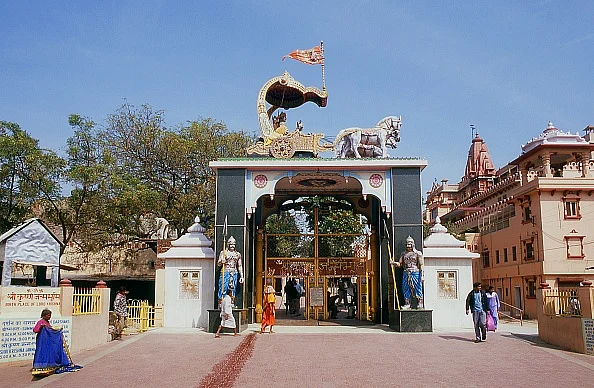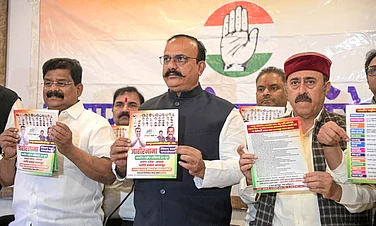After the successful inauguration of Ram Temple in Ayodhya, demands have intensified seeking temple construction on disputed lands in Mathura and Varanasi where two mosques currently stand. In Varanasi, a survey was conducted by the Archeological Survey Of India (ASI) in the barricaded area of the 17th-century Gyanvapi mosque, which ultimately concluded that a “large Hindu temple” existed there, parts of which were apparently used in the construction of the existing structure. Meanwhile, a debate has been brewing over the “evidence” of another Hindu temple next to Shahi Idgah Mosque on a plot of land in Mathura, which Hindutva groups consider to be Krishna Janmabhoomi Sthal, or the birthplace of Lord Krishna.
The Allahabad High Court is set to hear on February 22 a plea regarding maintainability of the suit seeking removal of Shahi Idgah mosque in Mathura, which it claims has been built on 13.37-acre land of Katra Keshav Deo temple.
A Decades-Old Dispute Over Krishna Janmabhoomi
On September 24, 2020, Lucknow resident and advocate Ranjana Agnihotri and six others had filed a plea in the lower court to remove the 17th-century Shahi Idgah mosque built by Mughal emperor Aurangzeb from the complex it shares with the Katra Keshav Dev Temple, close to the spot known as 'Krishna Janmabhoomi'. The petitioners filed the pleas under "next friend of Bhagwan Sri Krishna Virajman".
However, the dispute is even older than that. The ownership of 13.37-acre plot surrounding the Krishna Janmabhoomi where both the idgah and temple are built has been a hotly contested question for more than eight decades.
There are reports and historical records claiming that the mosque was built around 1669 next to the ruins of the Krishna temple. At the start of the 20th century, the land was owned by the King of Varanasi. In 1935, the Allahabad High Court upheld the ownership. In 1944, the land was purchased by the businessman Yugal Kishor Birla who went on to launch the Sri Krishnabhoomi Trust with the intention to build a Krishna temple in the area. In 1958, the Shri Krishna Janmasthan Seva Sangh took over the roles and responsibilities of the trust.
Reigniting The Controversy
There are more than a dozen applications contesting the plot of land in Mathura. But the one that gained momentum was the one filed in 2020. The lawsuit by the Hindu side claimed that the mosque “illegally encroached” on the land of the temple. According to the suit, "the Committee of Management of Trust Masjid Idgah entered into an illegal compromise on October 12, 1968, with the Society Shree Krishna Janamasthan Seva Sangh and both have played "fraud upon the court, the plaintiff deities and devotees" with a view to capture and grab the property in question. They also cited historical evidence cited in the petition, Aurangzeb had issued a decree in 1670 CE to demolish the temple, leading to the construction of the Shahi Idgah Mosque at the site.
Meanwhile, other applications submitted that Hindu religious symbols and engravings, characteristic of a temple, were seen at the base of a pillar, and an image of Hindu deity ‘Sheshnag’ was also found.
In May last year, the Allahabad High Court transferred to itself all 15 cases related to the Sri Krishna Janmabhoomi-Shahi Idgah Masjid dispute. On December 14, it allowed a court-monitored survey of the complex and agreed to the appointment of an advocate commissioner to oversee the survey of the mosque premises. However, the mosque management committee challenged this in the Supreme Court on the grounds that the lawsuit is barred by the Places of Worship (Special Provisions) Act, 1991, which puts a bar on change of character of religious places after August 15, 1947. The Ram temple in Ayodhya was the only exception to the 1991 law.
The top court stayed the implementation of Allahabad HC order for survey and sought a reply from the Hindu side. The court, however, allowed proceedings before the high court to continue.
Was There Really A Hindu Temple?
According to an RTI reply, accessed by Times Of India, the office of the superintending archaeologist of ASI, Agra circle, said: "Portions of Katra mound which are not in the possession of nazul tenants on which formerly stood a temple of Keshavdev which was dismantled and the site utilised for the mosque of Aurangzeb." The RTI was filed by Ajay Pratap Singh, a resident of Mainpuri in Uttar Pradesh.
As the clamour grows over Mathura temple row, which draws parallel with the dispute over Gyanvapi mosque, a question remerges over the politicising of religion. At a recent public gathering, Uttar Pradesh Chief Minister Yogi Adityanath, quoting Ramdhari Singh Dinkar's 'Rashmirathi', said that while Krishna asked the Kauravas to give five villages, “the society and its faith” in the state “was seeking just three”, referring to Mathura, Varanasi and Ayodhya. While the RTI reply still does not explicitly mention 'Krishna Janmabhoomi', it could play a significant role in how the legal battle pertaining to places of worship progresses in the days to come.


























